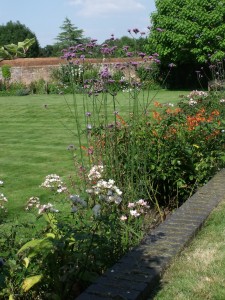THE MODERN MINT BLOG
Verbena Bonariensis
We know we know – Verbena bonariensis is so well known, planted in so many gardens, that it has become uncool to use it these days. Its ubiquitiousness means it gets judged in harsher tones than other plants, as if its popularity has made it offensive.
This is not the Verbena’s fault. It became popular for a reason – it weaves its way around the garden but doesn’t out compete other plants, it provides height and structure, encourages wildlife, is a gorgeous purple, looks good with other plants and fits into schemes as diverse as a country meadow to urban minimalism. Who wouldn’t want a plant like that? (Possibly the people of Buenos Aires, where this Verbena was discovered and given its name ‘bonariensis’… we’ve not noticed it around the city recently. Time for a trip and take a better look? See if the Argentines are enjoying one of their own…?)
At Modern Mint we refuse to let this lack of love for the plant deter us – a heinous crime against the arbitrarial zeitgeist of good taste it currently may be, but it is a plant with wonderful qualities (for an example of how it is currently viewed, note that it didn’t make it into Dan Pearson’s list.)
The wheels will keep turning and it will come back into fashion, hopefully this time considered the great garden plant it is.
Where and how do you use it?
Plant it in full sun or part shade.
Don’t cut it down before winter, let it stand (and seed.)
It looks great alongside shrub roses, or Miscanthus…
It prefers a damper soil. Really, it does. Henk Gerritsen told us, and observations we made from our own experiments lead us to agree…
“I sometimes made deadful miscalculations. For example, I assumed that due to their lanky growth Verbena bonariensis and Verbena hastata loved aridity, but in practise I noticed that they wilted away in dry places. Only later did I read that in the wild both species grow in moist places, in South and North America respectively.”
That concludes our ode to Verbena bonariensis. We hope you dismiss the current vogue of not using Verbena, and enjoy it as the brilliant garden plant it is.
(And click on the link below to take you to the wonderful Henk Gerritsen book we quoted from above…)
Michael Gibson, New York Topiary Art!
In the New York Times earlier this year was a lovely interview with Michael Gibson, who makes topiary and gardens in New York. The article is here but you may not have access… however, search the internet, find it and have a read. It is great! His philosophy of pruning is especially worth it… Sacred geometry in topiary? Yes please! What a phrase! I think (and speak) of balance, of major and minor, of leaf volume… but sacred geometry might well make it into my topiary teaching lexicon! And the idea of directional trimming? I realise I do this, but …
Topiary Library
I do a lot of teaching topiary. I had the opportunity from my mentor, Charlotte Molesworth, to work on her garden and experiment and test techniques and generally try making shapes without the worry of failure, or being fired, or being sued and run out of business for getting it wrong. This opportunity was essential (along with Charlotte’s insistance that pruning standards had to be high!) in becoming better at topiary. When I look around the world at our cultural vitamins, what we see in the media day in and day out, I see the stupidest and grossest of people …
Clipsham Yew Tree Avenue
With Chris Poole of the European Boxwood and Topiary Society we visited Clipsham Yew Tree Avenue in Rutland. Do you know it? Amazing place! Chris and I were teaching a topiary workshop in order to give local people the skills and technique, and tenacity! to help with the pruning of the avenue and elevate it to something even more special than it already is. Read more about the workshops here. We hope to run a further workshop in September 2026, as well as teach an advanced course too. Check the teaching page through the year as it will be updated …

